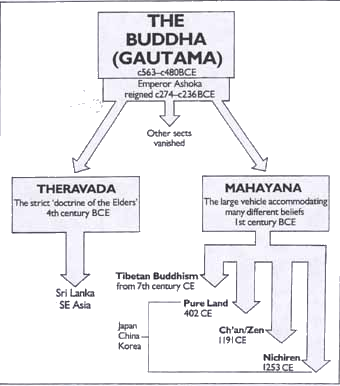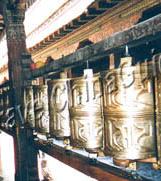 Religion
Religion
 Buddhism
Buddhism
Don's Home
 Religion
Religion
 Buddhism
Buddhism
| Contact |
 Under Construction. Under Construction.
Buddhism grew out of Hinduism similar to the way that Christianity grew out of Judaism. According to Pali Buddhism, the Buddha rejected being deified, in some streams of Mahayana Buddhism Gautama Buddha is worshipped as 'an omnipotent divinity endowed with numerous supernatural attributes and qualities' Sects Theravada
Theravada- Referred to as Hinayna by the Mahayanists - Thailand, Ceylon, Laso, Cambodia &K Burma Mahayana Buddhism - China, Korea, Japan, Tibet and Nepal - Nichiren Shoshu - - Zen - Tibetan/Tantric (some consider it part of Mahayana) - Tibetan Buddhism SitesDharma HavenWheel of Dharma The wheel of Dharma is one of the most important religious Buddhist symbols. The symbolises the Buddha's turning the Wheel of Truth or Law. The wheel refers to the story that shortly after the Buddha achieved enlightenment, Brahma came down from heaven and requested the Buddha to teach by offering him a Dharmachakra.
The wheel of Dharma is one of the most important religious Buddhist symbols. The symbolises the Buddha's turning the Wheel of Truth or Law. The wheel refers to the story that shortly after the Buddha achieved enlightenment, Brahma came down from heaven and requested the Buddha to teach by offering him a Dharmachakra.
The eight spokes of the wheel symbolize the Noble Eightfold Path set out by the Buddha in his teachings. Prayer Wheels Prayer wheels, called Chokhor in Tibetan, are very common religious objects in Tibet. They are sometimes referred to as Mani wheels. Prayer wheels, called Chokhor in Tibetan, are very common religious objects in Tibet. They are sometimes referred to as Mani wheels.They are devices for spreading spiritual blessings and well being. Rolls of thin paper, imprinted with many, many copies of the mantra (prayer) Om Mani Padme Hum, printed in an ancient Indian script or in Tibetan script, are wound around an axle in a protective container, and spun around and around. Typically, larger decorative versions of the syllables of the mantra are also carved on the outside cover of the wheel. It is common for bucket-sized prayer wheels to be lined up on wooden racks along walking paths circling monasteries and other sacred sites, for the benefit of visiting pilgrims. Larger water, fire, and wind prayer wheels are built so that they are empowered by the flowing water, the flaming light, and the blowing wind which drive them, and can later pass their positive karma to all who touch them. See Prayer Wheel at Travel China Guide | |
Mani Mantra (Prayer)" Om Mani Padme Hum"Click to play:  
Tibetan Buddhists believe that saying the mantra (prayer) invites the blessings of Chenrezig, the embodiment of compassion.
Om Mani Padme Hum can not really be translated into a simple phrase or even a few sentences.
Six PerfectionsTo dream of reaching a destination is not enough you must pack your bags and set out on the journey. Bodhisattvas who are intent on enlightenment for the sake of all living beings make this a reality by adopting a certain way of life. All the advice the Buddha gave on this way of life and on the multifarious activities in which Bodhisattvas engage can be subsumed in the six perfections of giving, ethical discipline, patience, enthusiastic effort, concentration and wisdom. They comprise every practice needed to fully ripen oneself and others.Four Noble Truths: - The truth of suffering (dukkha) - The truth of the cause of suffering (samudaya) - The truth of the end of suffering (nirhodha) - The truth of the path that frees us from suffering (magga) The Four Seals: -All compounded things are impermanent. -All emotions are painful. This is something that only Buddhists would talk about. Many religions worship things like love with celebration and songs. Buddhists think, "This is all suffering." - All phenomena are empty; they are without inherent existence. This is actually the ultimate view of Buddhism; the other three are grounded on this third seal. - Nirvana is beyond extremes. The Eightfold Path : 1. Right View 2. Right Intention 3. Right Speech 4. Right Action 5. Right Livelihood 6. Right Effort 7. Right Mindfulness 8. Right Concentration See The Eightfold Path WritingsA Koan is a short story, often a dialog between a student and a teacher, that points towards some essence of the spirit of Zen.
Links: Links: A Basic Buddhism Guide: 5 Minute Introduction Buddhism at ReligiousTolerance.org United Communities of Spirit (Orign.org) Buddhism and Christianity Sutta &\1 Sutra at UrbanDharma.org Buddha: Atheist or God: The Reluctant Messenger The Ultimate Reality in Buddhism< What Are the Basic Teachings of Buddhism? | eHow.com Parables See Buddhist Symbols at religious-symbols.net and ancient-symbols.com Return to Religion or Tibet |